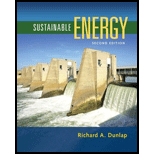
Sustainable Energy
2nd Edition
ISBN: 9781337551663
Author: DUNLAP, Richard A.
Publisher: Cengage,
expand_more
expand_more
format_list_bulleted
Concept explainers
Question
Chapter 4, Problem 16P
To determine
Compare the adiabatic lapse rate (ALR) for the troposphere obtained from Figures 4.7 and 4.8 with the value in the text.
Expert Solution & Answer
Trending nowThis is a popular solution!

Students have asked these similar questions
A tall stack and a nearby short stack have plumes as shown in the Figure. Which atmospheric temperature profile would be most likely to cause that pair of plumes? The dotted lines represent the dry adiabatic lapse rate.
A stack 75 m tall ( as shown) emits a plume at 20 oC. The surrounding air is at 20 oC. Is the resulting plume looping, fanning, fuming, or lofting?
Civil engineering: Energy
Please solve the problem clearly , don't use previously solved solutions.
I am asking this for a second time.
Hope you understand
Question:
The atmosphere is stable with a lapse rate of -0.2 degree C/100 m. The surfaces air temperature is 15 degree C. A parcel of air is released at the ground with a temperature of 25 degree C. Calculate the maximum mixing height, in m.
Knowledge Booster
Learn more about
Need a deep-dive on the concept behind this application? Look no further. Learn more about this topic, civil-engineering and related others by exploring similar questions and additional content below.Similar questions
- A 440-MW coal-fired power plant is burning coal that contains 185 ppb of mercury. The coal firing rate is 300,000 Ib/hr, and the flue gas flow rate is 1.0 million scfmarrow_forwardCan I get a step by step on how to answer? Given the conditions below of a power plant, determine the concentration of SO2 at a point 5 km downwind on an overcast summer afternoon and 0.3 km perpendicular to the plume centerline (y = 0.3 km) if there is an inversion with a base height of 388 m. Assume SO2 emission as 1,645 g/s and wind speed as 3.5 m/s. Stack parameters: Height = 220.0 m, Diameter =2.20 m Exit velocity = 12.0 m/s , Temperature 315°C Atmospheric conditions: Pressure 98.0 kPa; Temperature 25.0°C Use Cu/Q equation and Graphs from FE Exam Handbook to solve this problem.arrow_forwardOn a summer day, the mean solar irradiance received at a lake was 500 W/m^ 2 over 25 days (consider the day length to be 8 hours). If 80% of the energy is used to vaporize water, how large could the depth of evaporation be?arrow_forward
- A heat source of unknown temperature supplies energy of (R+650)kJ to a carnot heat engine. If this engine sends (R+250)kJ to a sink at (R+26)C find, 1. The temperature of the heat source and 2. The efficiency of the heat engine R= 83arrow_forwardA hemispherical tank is horizontal across the top. It contains a liquid whose surface is 3.11 meters below the top. The liquid has a total mass of 3,008 kilograms. If the liquid surface has a radius of 3.72 meters, determine the specific gravity of the liquid inside the tank. Round off to three decimal places.arrow_forwardGiven the total global production of N2O in 2006 as 17.9 Teragrams of N/year and the global mixing ratio of N2O in 2006 as 320 ppb as N2O. Use the following equation to calculate residence time of N2O in the atmosphere. (The total moles of air in the atmosphere is 1.62 x 10 20). t=Q/P Where Q is the total mass and P is the productionarrow_forward
- Calculate the specific energy of 13 m3/s of water flowing with a velocity of 1.5 m/s in a rectangular channel 7.5 m wide. Find the depth of water in the channel when the specific energy would be minimum. What would be the value of critical velocity as well as minimum specific energy?arrow_forwardCan I get a step by step on how to answer? Determine the atmospheric stability for each of the following temperature profiles. Show all work and explain choices.arrow_forwardcalculate the density and specific weight of carbon dioxide at an absolute pressure of 300 kN/m^2 and 60 degree celsiusarrow_forward
- A 0.8 lbm object traveling at 200 ft/sec enters a viscous liquid and is essentially brought to rest before it strikes the bottom. What is the increase in internal energy, taking the object and the liquid as the system? Neglect the potential energy change.arrow_forwardThe volume of atmospheric water is 12669km3. The evapotranspiration from land is 7200 km3 per month and from ocean is 505000 km3 per year. Estimate the residence time of water molecules in the atmosphere in a month.arrow_forwardThe ozone concentration [O3] sometimes reaches a value of 0.25 ppm over a 1 hour period in urban areas with photochemical smog problems. Determine by what percentage this level exceeds the pre 1997 national ambient standard of 240 micrograms/cubic meter for the given time period, if the termperature is 25 degree celsiusarrow_forward
arrow_back_ios
SEE MORE QUESTIONS
arrow_forward_ios
Recommended textbooks for you

 Engineering Fundamentals: An Introduction to Engi...Civil EngineeringISBN:9781305084766Author:Saeed MoaveniPublisher:Cengage Learning
Engineering Fundamentals: An Introduction to Engi...Civil EngineeringISBN:9781305084766Author:Saeed MoaveniPublisher:Cengage Learning


Engineering Fundamentals: An Introduction to Engi...
Civil Engineering
ISBN:9781305084766
Author:Saeed Moaveni
Publisher:Cengage Learning